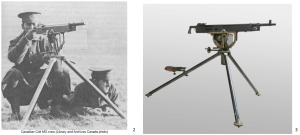Friday, January 22, 1915
In Camp, Lark Hill, Salisbury Plains
The Battalion War Diarist wrote for this day: “Musketry on Durrington Range.” [1]
 THIS DAY IN RMR HISTORY: Col. Duguid wrote that in 1914 “The Canadian establishment of battalion machine guns was increased from two to four; the Vickers guns ordered in England were, however, not delivered because the whole output was reserved for the War Office, which on 15th October, offered thirty Maxim guns temporarily in lieu. It was evident that American manufacturers would have to be relied on, for the present at least, to provide machine guns for the Canadian forces, and an order for 250 Colt guns was placed on 17th October. Fifty Colt guns had already been ordered on 29th August but deliveries were slow; 17 were issued to infantry battalions on Salisbury Plain on 26th November, and the remainder reached there only on 31st January. There were several serious difficulties with the Colt gun, which was not well adapted to fire British ammunition; all the sights required readjustment and were sent to Birmingham; the tripod was found by a board of officers assembled on 4th December to be unsatisfactory, clumsy, heavy, and not adjustable as to height; three alternative mountings were tried, one of which, placed on wheels, was manufactured partly by civil contract in Bristol, partly by artizans in the Contingent. Other mechanical defects were reported but could not be remedied before the Division proceeded to France.
THIS DAY IN RMR HISTORY: Col. Duguid wrote that in 1914 “The Canadian establishment of battalion machine guns was increased from two to four; the Vickers guns ordered in England were, however, not delivered because the whole output was reserved for the War Office, which on 15th October, offered thirty Maxim guns temporarily in lieu. It was evident that American manufacturers would have to be relied on, for the present at least, to provide machine guns for the Canadian forces, and an order for 250 Colt guns was placed on 17th October. Fifty Colt guns had already been ordered on 29th August but deliveries were slow; 17 were issued to infantry battalions on Salisbury Plain on 26th November, and the remainder reached there only on 31st January. There were several serious difficulties with the Colt gun, which was not well adapted to fire British ammunition; all the sights required readjustment and were sent to Birmingham; the tripod was found by a board of officers assembled on 4th December to be unsatisfactory, clumsy, heavy, and not adjustable as to height; three alternative mountings were tried, one of which, placed on wheels, was manufactured partly by civil contract in Bristol, partly by artizans in the Contingent. Other mechanical defects were reported but could not be remedied before the Division proceeded to France.
The only other firearms in the hands of the Contingent were the Colt 45 automatic pistol, and the Webley or Smith &Wesson revolver of the same calibre. These were carried by officers, warrant officers, certain n.c.o.’s, signallers and other specialists.” [i]
[1] War Diary, 14th Canadian Battalion, The Royal Montreal Regiment, Jan 22, 1915. Library and Archives Canada, Ottawa, http://data2.collectionscanada.ca/e/e044/e001089686.jpg
[2] Library and Archives Canada, found at: http://www.canadiansoldiers.com/weapons/lightweapons/machineguns/coltmachinegun.htm
[3] http://www.warmuseum.ca/firstworldwar/objects-and-photos/weapons-and-ammunition/firearms/colt-machine-gun/
[4] Col. A.F. Duguid, “Official History of the Canadian Forces in The Great War 1914-1919, Vol. 1, Part 1,” King’s Printer, Ottawa, 1938, pp. 137-138.

